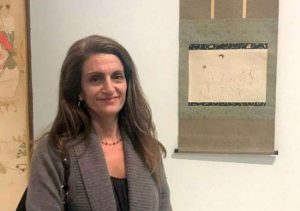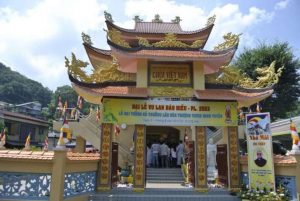“You really need to meet my friend; she’s danced the bardo.” The bardo is the intermediate after-death state described in the Tibetan Book of the Dead. It’s not every day that I am introduced to an artist with the opener that she’d danced the Tibetan Book of the Dead. My friend was right, however: I did need to meet Virpi Pahkinen, a Scandinavian contemporary dancer, born in Finland, and based in Stockholm. She is herself an indigenous Finno-ugrian, who identifies with temple dancers and indigenous shamans as her artistic and spiritual ancestry. Critics have called her an East-West shaman, and made observations about “Asiatic” influences in her work.
I was in Stockholm to deliver a talk to the Swedish Bhutan Society, “Mystical Dances in the Kingdom of Bhutan.” It was a robust and mixed audience of top scholars, associates of the renowned Dance Museum in Stockholm, curators, multi-generational explorers of the Himalayas, dancers with long careers at the Royal Swedish Ballet—one of the finest and oldest ballet companies in the world—and a famous avant-garde solo dancer, Virpi Pahkinen. There was a buzz about her attending. The diverse interests being drawn to Himalayan monastic and mystical dances were broad and mutually enriching.
One excellent aspect of my talk event in Stockholm was that a lovely outdoor reception was held in advance of the talk. People got to know each other; know who else was there. It added immensely to the collective vibe and eagerness to see what these dances had to reveal. In fact, many in the audience had seen Buddhist monastic dance, or encountered it in situ, but they had no idea what it was or why.
Dancers are interested in other dances as dance, not as religious scholarship. For an artist, dance is the entry into Buddhism; not some side note to textual study, but something experiential. Buddhism is, after all, something you do. Buddhism offers unique contributions to understanding the nature of dance itself. Artists have always been drawn to the expansive capacity of Buddhist principles. In the West, Buddhism has been associated with avant-garde performance for more than 50 years.

Encounters with Buddhism have invigorated performance forms since the dawn of Buddhism. Buddhist dances exist in Bhutan, China, India, Japan, Nepal, Sri Lanka, Tibet, and beyond. In each place, local forms were transformed with the application of Buddhist concepts, principles, and practices. Contemporary artists, from Philip Glass to Meredith Monk, have created avant-garde works deeply inspired by their own Buddhist practice of meditation and understanding of principles, applied to music, movement, and visuals.
It is one thing to have an academic interest in the dance; an anthropological, or even dance research-based interest in Buddhist practices. It is quite another to be a contemporary Western artist inspired by something like the Tibetan Book of the Dead, full of dance imagery as it is. Wrathful deities dance—that is what they do. They don’t walk. The bardo, or after-death state, is one of increasing disembodiment, finally liberating one to enlightenment, or sealing one’s fate to be reincarnated and living another life. Virpi was reading the Tibetan Book of the Dead when she was approached about creating a site-specific dance performance.
“An old water tower by architect Ferdinand Boberg was available.” Virpi explains. “I was reading the Tibetan Book of The Dead at that time. I came up with the idea with different deities from the different cardinal points, or directions, in brain. So, first there was this 20-minute dance for television, Bardo 010. It was a popular success.
“Then I wanted to make a stage version for the Dansens Hus big stage in Stockholm in 1998. It garnered great reviews and was invited to Taiwan. Parts of Bardo 010 was shown at Dance Salad Festival in Houston in 2003, and the music by Akemi Ishijima has lived on and I have made new choreography for that.”

“We had a man swaying in the air on the oval wooden swing. We called him a bardo-traveler, the one who experiences the state of bardo.Three dancers were the same, both in stage and TV-version: Patric King, Shen Wei, and me. The costumes and make up were the same as well. Music by Akemi Ishijima was a prolonged version, and we dancers were reading from The Tibetan Book of the Dead in four languages. The English version is read by Patrick King. What I say in Finnish is something like:
‘The deities are not big and not small, but just in right proportion. They carry different jewels, they sit on their thrones, and they hold the emblems. . . .’”
Virpi dances with internationally acclaimed dancers, Shen Wei and Patric King, each a testament to the calibre of the others. Although the dance was years ago, it remains fresh in peoples’ minds, even making it an introduction to Virpi Pahkinen. Please enjoy this clip of excepts from Bardo 010.
Bardo short cuts

Virpi presents her own spirituality as dance being based on a lifetime of wanting to understand and connect with spirit, but not aligning with religious notions of God. Extreme physicality was her refuge: figure skating, gymnastics, and dancing. Finally accepting herself as the artist and spirit, already connected, her dancing took on a heightened energetic quality; something transcendent that speaks to many people. One fellow dancer asked her if she could “charge herself” on Virpi’s radiant energy. A young boy, a hip-hop dancer in Houston, approached her after a solo performance, and asked her if she was from the future.

Virpi is a well-known performer in Sweden, celebrated for her profound expressivity. When I pressed her about her training, she revealed that she had a long working relationship with the great director Ingmar Bergman, who first used her in a production of Peer Gynt at the Royal Dramatic Theatre in Stockholm. He nearly didn’t hire her because of her unusual hairstyle. But, in time, she became his favorite, and over a decade together, Virpir danced in Bergman’s productions of Shakespeare’s The Winter’s Tale, and Time and the Room by Botho Strauss. Bergman asked Virpi to assist the choreographer his production of Euripides’ The Bacchae,and to dance in The Goldberg Variations. Their final work together, Strindberg’s Ghost Sonata, set to Bartok’s music for celesta and orchestra, had Virpi dancing, playing a milk maid, who, for Bergman, was an angel of death. She was the only dancer in this show.

In her own words: “In a church or likewise in ‘natural temples’ outdoors, it becomes clear that the whole body can stretch, fall, bend, and float in prayer. We have within us a spiritual spark that cannot always be formulated in words and does not want to be pressed into language. It is the other parts of brain that want to be expressed.”
As a teenager growing up in Jyväskylä, in central Finland, she practiced figure skating on a nearby lake. “When the lake was free of snow, I could dance at night alone under the full moon. . . . The lake was black and shiny. It was freezing cold, but magical, like one was at home in the universe.”
For me, the dance works like a prayer and hopefully it can work for the audience as well. The idea of dance as a prayer—heartfelt—is familiar to me since a long time back. I have titled some of my solos: Prayer of a Scorpio, Prayer to the Ascending, Prayer for the One Whose Trembling Hands are Still, Blue Prayer.”
Virpi Pahkinen is a shining example of a talented performing artist inspired by Buddhism to explore new and unknown aspects of creativity as part of a lifelong quest to explore spiritual experience as the practice of dance. After meeting her, I am so grateful to my friends in Stockholm, who insisted, “You really have to meet my friend; she’s danced the bardo.”
That and so much more.
Virpi Pahkinen is the embodiment of dance as a spiritual and lifelong practice.
See more
Related features from BDG
Anti-War Performance, Part One
Anti-War Performance, Part Two













